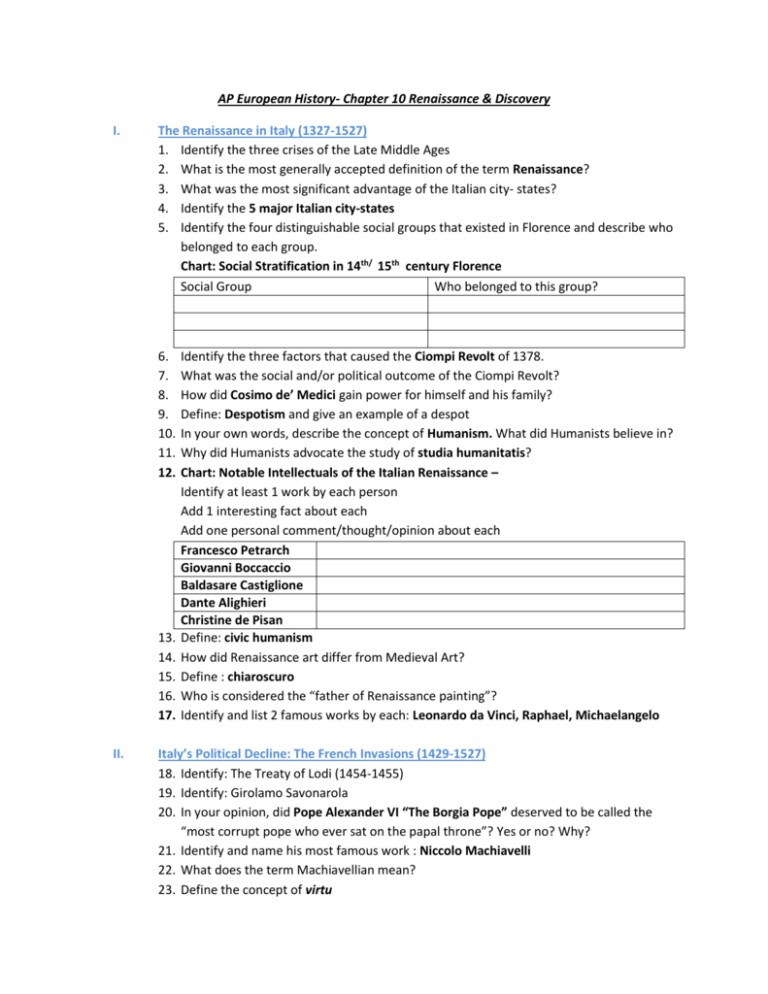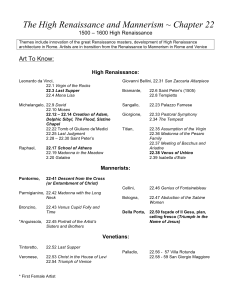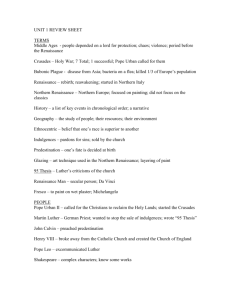AP European History- Chapter 10 Renaissance & Discovery The
advertisement

AP European History- Chapter 10 Renaissance & Discovery I. The Renaissance in Italy (1327-1527) 1. Identify the three crises of the Late Middle Ages 2. What is the most generally accepted definition of the term Renaissance? 3. What was the most significant advantage of the Italian city- states? 4. Identify the 5 major Italian city-states 5. Identify the four distinguishable social groups that existed in Florence and describe who belonged to each group. Chart: Social Stratification in 14th/ 15th century Florence Social Group Who belonged to this group? 6. 7. 8. 9. 10. 11. 12. 13. 14. 15. 16. 17. II. Identify the three factors that caused the Ciompi Revolt of 1378. What was the social and/or political outcome of the Ciompi Revolt? How did Cosimo de’ Medici gain power for himself and his family? Define: Despotism and give an example of a despot In your own words, describe the concept of Humanism. What did Humanists believe in? Why did Humanists advocate the study of studia humanitatis? Chart: Notable Intellectuals of the Italian Renaissance – Identify at least 1 work by each person Add 1 interesting fact about each Add one personal comment/thought/opinion about each Francesco Petrarch Giovanni Boccaccio Baldasare Castiglione Dante Alighieri Christine de Pisan Define: civic humanism How did Renaissance art differ from Medieval Art? Define : chiaroscuro Who is considered the “father of Renaissance painting”? Identify and list 2 famous works by each: Leonardo da Vinci, Raphael, Michaelangelo Italy’s Political Decline: The French Invasions (1429-1527) 18. Identify: The Treaty of Lodi (1454-1455) 19. Identify: Girolamo Savonarola 20. In your opinion, did Pope Alexander VI “The Borgia Pope” deserved to be called the “most corrupt pope who ever sat on the papal throne”? Yes or no? Why? 21. Identify and name his most famous work : Niccolo Machiavelli 22. What does the term Machiavellian mean? 23. Define the concept of virtu III. Revival of Monarchy in Northern Europe 24. Why was the alliance between town and king after 1450 significant? 25. Identify three advantages of the sovereign state 26. France: Identify the two political cornerstones of the 15th century French nation building 27. France: Describe the contributions of Jacques Coeur 28. Spain: Why is the marriage of Ferdinand of Aragon and Isabella of Castile (1469) so significant in Spanish history? 29. Spain: identify two goals of Ferdinand and Isabella 30. Who was exiled from Spain in 1492? 31. Define: Conversos, Moriscos 32. What is Ferdinand and Isabella of Spain’s most famous contribution to world history? 33. England: What happened after the Hundred Year’s war? What is this conflict called? Why? 34. Who emerged as King of England at the end of the War of the Roses? 35. The Holy Roman Empire is comprised of which two territories? IV. The Northern Renaissance 36. Who invented the printing press? 37. One of the most significant inventions of all time was the printing press. Why? What impact did the printing press have on Europeans? 38. Why did the writings of Desiderius Erasmus appeal to both Catholics & Protestants? 39. Who is the best known English humanist? What work is he best known for? V. Voyages of Discovery and the New Empires in the West and East 40. Chart: Voyages of Discovery Explorer Famous for… Year/ Country he sailed for Prince Henry the Navigator Bartholomew Dias Vasco da Gama Christopher Columbus Amerigo Vespucci Ferdinand Magellan 41. In your own words, describe what happened after Hernan Cortes landed in Mexico in 1519. 42. In your own words , describe what happened after Francisco Pizarro landed on the western coast of South America (Peru) in 1532 43. What year did the Aztec empire fall in the hands of the Spanish Hernan Cortes? What year did the Inca empire fall in the hands of the Spanish Francisco Pizarro? 44. Identify: Bartolome de las Casas 45. What is the “black legend”? 46. The colonial economy of Latin America had three major components. List them. 47. Define: encomienda, repartimiento, mita AP European History- Chapter 10 Renaissance & Discovery OPTIONAL: A list of people, terms, and events- For those of you that would like to create flashcards. This optional list can also be used as a study guide. 1. 2. 3. 4. 5. 6. 7. 8. 9. 10. 11. 12. 13. 14. 15. 16. 17. 18. 19. 20. 21. 22. 23. 24. 25. 26. 27. 28. 29. 30. 31. 32. Renaissance 5 major Italian city-states 4 social classes in Florence Ciompi Revolt Cosimo de’ Medici Despot(ism) Humanism Studia humanitatis Francesco Petrarch Giovani Boccaccio Dante Alighieri Baldasare Castiglioni Christine de Pisan Civic humanisn Characteristics of Renaissance art Chiaroscuro Giotto Leonardo da Vinci Raphael Michaelangelo Pope Alexander VI “The Borgia Pope” Niccolo Machiavelli Virtu Spain - Ferdinand of Aragon and Isabella of Castile England- War of the Roses Holy Roman Empire Johannes Gutenberg & the Printing Press Desiderius Erasmus Thomas Moore Factors that encouraged overseas exploration Prince Henry the Navigator Christopher Columbus 33. 34. 35. 36. Columbian Exchange Hernan Cortes – Fall of Aztec Empire (Mexico) 1521 Francisco Pizarro – Fall of Inca Empire (Peru) 1532 Bartolome de las Casas





